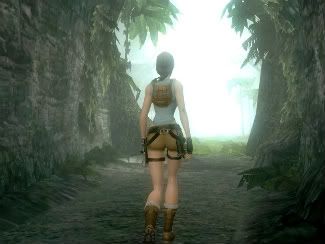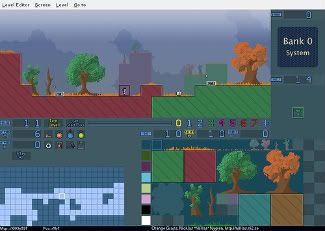
When it first occurred to me that I should write a little piece on Out of this World, my thoughts turned to pulverizing it, ripping it to shreds ; anything to get some revenge for the feelings of unabashed anger it was awaking at the time. The experience I was getting out of it was that of being utterly condescended to, and the only reason I had to keep playing was out of personal curiosity and respect for the artform. And yet, when I finally arrived at the end... the only thing I could think about was playing it again. And again the next day. And again some other time. It felt as if the game had put me under some kind of sick spell, and indeed it had conditioned me into learning its punishing patterns by heart. Naturally, I began to see it in a slightly different light, and gave it some more thought.
The core property that emerges from my experience of Out of this World is difficulty, but not difficulty of any old kind. This is not a game that tests one's ability to calmly reason through abstract situations, nor one that throws relentless reflex challenges and asks the player to adapt. It is a little bit of both, and a lot of something else: the unpredictable barriers it places in the player's path are always of a solid, physical nature, but are presented in such a way that barely offers any chance to react properly. Rarely have I seen a game allowing so little room for error on the part of the player, nor have I stumbled upon so precious feedback on the current state of my progress. To put it bluntly, getting through Out of this World by oneself requires a level of unmatched skill, patience and discipline ; one that I clearly wasn't able to muster.
But let me put this differently, in the form of a question: at what point does this brand of "discipline" cease to be a virtue, and becomes a simple act of foolish submission? It bears asking, because Out of this World contains an awful lot of instances which are way too demanding to plow through, even when the procedure is perfectly clear. Conversely, it also forces the player to endlessly repeat long stretches of empty gameplay, neverminding that the closing portion of each is the one most likely to end in a fatal misstep. Separating his rare checkpoints by increasingly complex chains of events, designer Éric Chahi has clearly wanted failure and frustration to be part of his game's experience, and his attention to scenes resulting only in death is further proof of this. But in this wild pursuit, has he overestimated the stubbornness of his potential audience? Did people even care about this in 1991?
Difficulty and tedium in games has been the subject of many discussions of late, not the least being Lewis Pulsipher's recent overview of the question on Gamasutra (some very interesting comments there, too). While the commonly-referred solutions proposed by Prince of Persia and New Super Mario Bros. have sparked some justified controversy, other appealing alternatives have been noticed in the smaller-scale indie space: Nifflas' games wisely spread save spots every few screens, allowing the player to concentrate on navigating one step at a time ; similarly, Terry Cavanagh's amazing Don't Look Back evens out its hardcore difficulty by making every screen a checkpoint with self-contained challenges. In most commercial PC games, this "problem" has been mostly resolved by the omnipresence of quick saves, allowing to refine and correct one's performance at will. But still, despite these tweaks and concessions, developers insist on making their games somewhat challenging. Surely there must be a good reason for this...
The core property that emerges from my experience of Out of this World is difficulty, but not difficulty of any old kind. This is not a game that tests one's ability to calmly reason through abstract situations, nor one that throws relentless reflex challenges and asks the player to adapt. It is a little bit of both, and a lot of something else: the unpredictable barriers it places in the player's path are always of a solid, physical nature, but are presented in such a way that barely offers any chance to react properly. Rarely have I seen a game allowing so little room for error on the part of the player, nor have I stumbled upon so precious feedback on the current state of my progress. To put it bluntly, getting through Out of this World by oneself requires a level of unmatched skill, patience and discipline ; one that I clearly wasn't able to muster.
But let me put this differently, in the form of a question: at what point does this brand of "discipline" cease to be a virtue, and becomes a simple act of foolish submission? It bears asking, because Out of this World contains an awful lot of instances which are way too demanding to plow through, even when the procedure is perfectly clear. Conversely, it also forces the player to endlessly repeat long stretches of empty gameplay, neverminding that the closing portion of each is the one most likely to end in a fatal misstep. Separating his rare checkpoints by increasingly complex chains of events, designer Éric Chahi has clearly wanted failure and frustration to be part of his game's experience, and his attention to scenes resulting only in death is further proof of this. But in this wild pursuit, has he overestimated the stubbornness of his potential audience? Did people even care about this in 1991?
Difficulty and tedium in games has been the subject of many discussions of late, not the least being Lewis Pulsipher's recent overview of the question on Gamasutra (some very interesting comments there, too). While the commonly-referred solutions proposed by Prince of Persia and New Super Mario Bros. have sparked some justified controversy, other appealing alternatives have been noticed in the smaller-scale indie space: Nifflas' games wisely spread save spots every few screens, allowing the player to concentrate on navigating one step at a time ; similarly, Terry Cavanagh's amazing Don't Look Back evens out its hardcore difficulty by making every screen a checkpoint with self-contained challenges. In most commercial PC games, this "problem" has been mostly resolved by the omnipresence of quick saves, allowing to refine and correct one's performance at will. But still, despite these tweaks and concessions, developers insist on making their games somewhat challenging. Surely there must be a good reason for this...

Following my time with Out of this World, and curious to further experience an era when challenge was a gameplay factor of utmost importance, I dove into some classic NES titles that I had never played before. Mega Man, Contra, Ninja Gaiden... ; all of these yielded great fun, and provided an eloquent snapshot of then-state-of-the-art game design. But what I discovered is that, while clearly presenting high levels of difficulty, these platformers still mostly unfolded in fair and consistent patterns, according to their respective rules. Throughout these series and other, equally regarded titles (Blaster Master, Bionic Commando...), this consciousness of the player's progression and learning process is ultimately the argument that justifies what some would claim to be a hostile and restrictive approach to game design. Unlike the arbitrary manner in which Out of this World spreads itself out, it is expected that the player might be skilled enough to bend the mechanics to his will upon first encounter of an obstacle, and that practice will only result in a better, cleaner, brisker performance. What these games lack, however, is the sheer abandon of Chahi's play with space and mechanics, which boldly screams confidence.
Indeed, there is just about nothing that resembles a near-perfect playthrough of Out of this World. While practically impossible to pull off, to do so is to witness a feat of interactive storytelling that few games would equal until the original Half-Life. It is the flexibility of Chahi's environmental designs and core interactions that, invariably, dazzles ; the basic blaster is made to serve a surprising number of purposes, while the few variations in the means of navigating, such as the brief "duct-rolling" segment, all turn out clever and memorable. On occasion, the obscurity of certain solutions even works to his advantage, such as having to dive back in the depths of a cave to section a power wire, which makes the game world fold back on itself and appear even more thought-out. But as I said earlier, the threat of death never ceases to hang over the protagonist, and often remains much too hard to avoid even after several runs. Thus, the experience of replaying Out of this World becomes curiously paradoxical: failing to replicate the confusion and despair of the initial exposure, it is replaced by a mastery that never feels quite complete, but allows the game, ever precariously, to expose its narrative drive and grace more transparently. Whether this response was anticipated by the author remains a mystery, but it certainly is this intriguing sensation that kept me going back to it.
And so I must wrap up this personal account of Out of this World, undoubtedly one of the most fascinating pieces of software I ever toyed with, and one that changed the way I look at other games, for better and for worse. While I was firmly intent on claiming its design to be one of the most appalling ever conceived in the beginning, people more knowledgeable than me have previously made a case for it as "the best video game of all time" in fairly convincing manner. Chris Lepine, in a now somewhat-famous essay, has thoughtfully praised the spirit of independence at play in the game, which does ooze freedom and creativity. By its very design and delivery techniques, Out of this World is a work that feels daring, focused, personal, even urgent. That those qualities manage to pierce through such a daunting and ruthless exterior is almost a miracle in itself, and one that is sure to have people talking for years to come.


